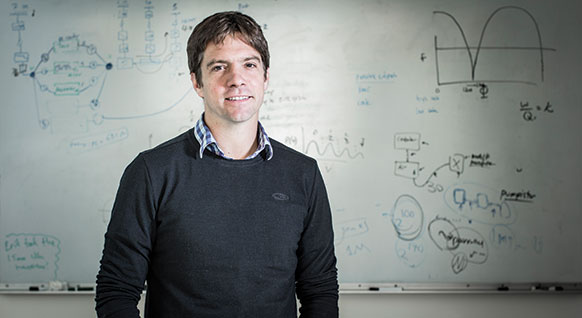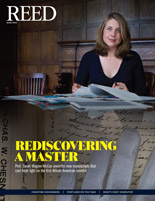
IRIS login | Reed College home Volume 94, No. 2: June 2015
Cheating Heisenberg

Other quantum researchers warned Murch to stay away from those “weird, crazy people” doing so-called “weak” measurements. Photo by Jennifer Silverberg.
Physicist Kater Murch ’02 pushes uncertainty to new limits—and poses deep questions about time’s arrow at the quantum level.
By William Abernathy ’88
It takes seven layers of wallboard and a thousand-pound door to quell the racket from the pumps that drive the pulse-tube refrigerator unit, an icy behemoth that drives the temperature down to 2.8 degrees Celsius above absolute zero. Then the dilution refrigerator kicks in, cooling the chamber to a mere 8 millikelvins, or eight thousandths of a degree above absolute zero.
“Pretty chilly,” says Kater Murch ’02 of his test apparatus.
It’s definitely the coldest spot in St. Louis—colder, in fact, than outer space. There are several reasons why Murch’s experiment takes place at the brink of absolute zero. First, at this temperature, electrons run free, utterly unrestrained by electrical resistance. More important, the cold dampens all the electromagnetic “noise” from the system. This is crucial, because Murch is investigating a quantum superposition—a state of existence at the outer boundaries of human understanding. His test subject is a quantum bit, an “artificial atom” that is in two separate states at the same time. Mathematically, and for all practical understanding, it is in both an excited and an unexcited “ground” state simultaneously. It’s both heads and tails. Murch’s experiments on this most ephemeral state of existence have forced quantum scientists to question anew the nature of time itself.
![]()
One of the pillars of modern physics, quantum theory deals with things that are very small, interacting in ways that would give Alice in Wonderland a migraine. To those of us raised on the straightforward, intuitive world of classical mechanics (read: everyone), quantum mechanics offers paradoxes that only make sense if you do the math—and the math is notoriously, irreducibly difficult.
One key tenet of quantum mechanics, called the “observer effect,” holds that any act of measurement inevitably disturbs the quantum superposition. You can measure a quantum system to learn its state, but the answer you get back won’t be of a quantum system: because you measured it, you get an answer, but prying an answer out of it knocks it out of superposition. The answer you get can be summed up as: heads... or tails, but you can’t catch it being both. This effect is an analogue of the German physicist Werner Heisenberg’s famous uncertainty principle, which holds that you can measure an elementary particle’s location or its momentum, but never both at once.
The observer effect received a theoretical challenge in 1988 by peripatetic Israeli physicist Yakir Aharonov, who proposed that weak measurements could be taken of a quantum system that would provide incomplete information about the quantum bit (qubit) without disturbing its superposition. By Aharonov’s suggestion, one might be able to interrogate the qubit slyly, with subtle hints of a measurement, rather than spoiling the mood by coming right out and measuring it directly.
Aharonov proposed weak quantum measurements to advance “two-state vector formalism,” a quantum theory he posited in 1964, which asserts time symmetry in quantum systems. Time symmetry is the suggestion that in a quantum system, time runs in two directions, rather than the single direction we all know and lament. Under the two-state vector formalism, to understand a quantum system fully, one must take into account all available information. Half of the information contained in a quantum system comes from before it is measured. The rest, his math suggested, must come from the future.
For obvious reasons, many scientists found this conjecture a bit hard to stomach. “There was an intense dislike for Aharonov and his ideas.” Murch says. “Physical Review wouldn’t publish his papers, because they didn’t want to give him any credence. There was sort of a refusal to accept these things.”
Being impossible to verify through conventional experimentation made two-state vector formalism easy to ignore. When he was originally taught quantum mechanics, Murch was counseled to “stay away from those weird, crazy people” doing weak measurements. Yet, he says, “I always wanted to understand weak measurements, and I said, ‘Someday I’ll do an experiment...’ ” Little did he know that his results would one day generate headlines around the world.
![]()

LATEST COMMENTS
steve-jobs-1976 I knew Steve Jobs when he was on the second floor of Quincy. (Fall...
Utnapishtim - 2 weeks ago
Prof. Mason Drukman [political science 1964–70] This is gold, pure gold. God bless, Prof. Drukman.
puredog - 1 month ago
virginia-davis-1965 Such a good friend & compatriot in the day of Satyricon...
czarchasm - 4 months ago
John Peara Baba 1990 John died of a broken heart from losing his mom and then his...
kodachrome - 7 months ago
Carol Sawyer 1962 Who wrote this obit? I'm writing something about Carol Sawyer...
MsLaurie Pepper - 8 months ago
William W. Wissman MAT 1969 ...and THREE sisters. Sabra, the oldest, Mary, the middle, and...
riclf - 10 months ago